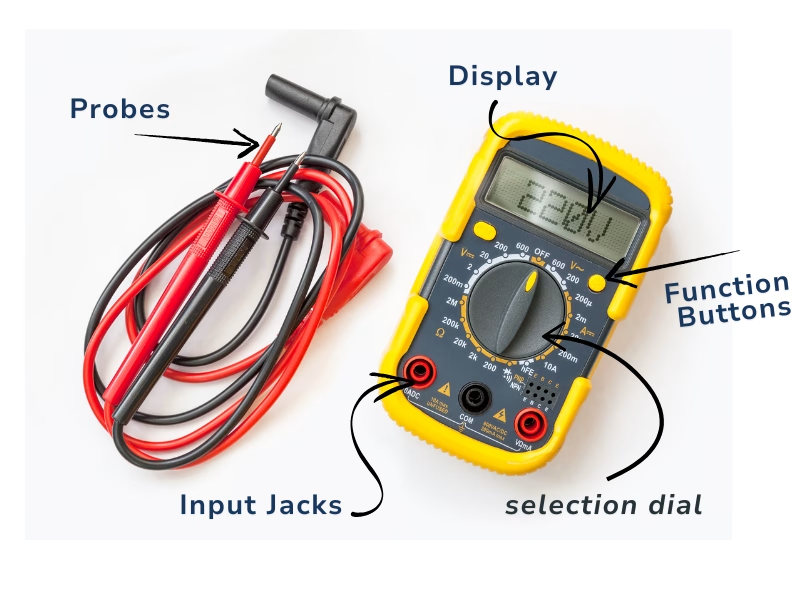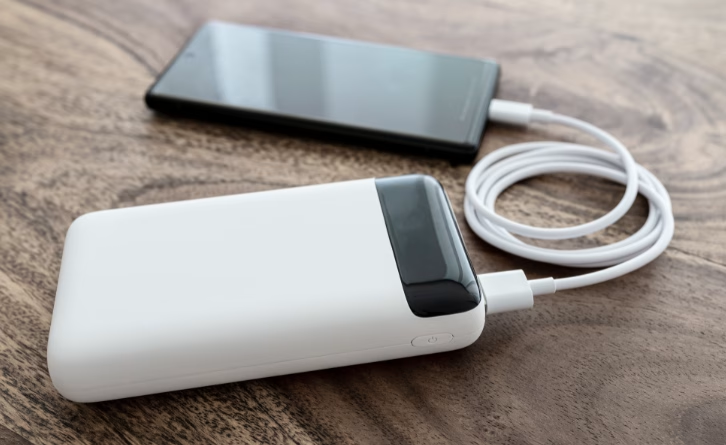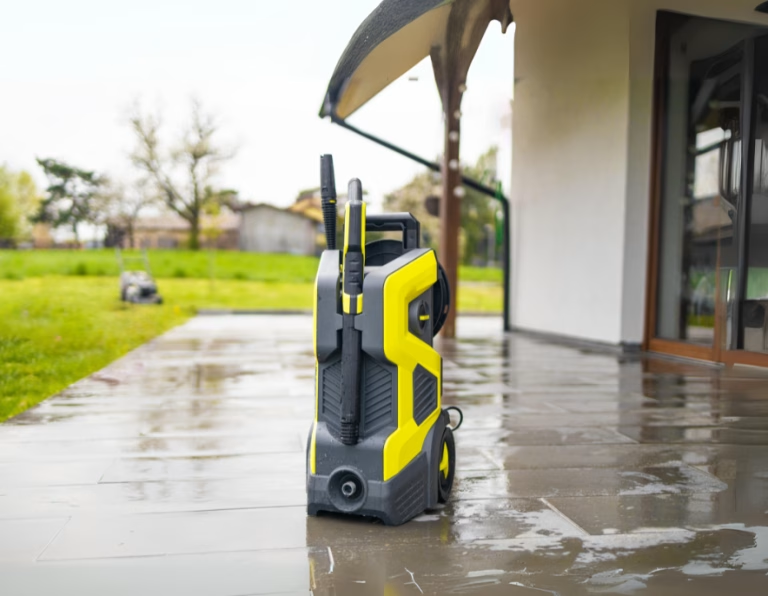Electrical tools are essential for both electricians and DIYers. This article covers the basic tools needed for DIY (Do It Yourself) projects or daily work as an electrician, helping to ensure safe and efficient work without any external assistance. Here are some essential electrical tools that every worker should have:
1_Multimeter
There are primarily two types of multimeters:
Analog Multimeters: These use a needle or moving pointer to display readings on a scale. They are less common nowadays due to their lower accuracy compared to digital multimeters.
Digital Multimeter: A digital multimeter (DMM) is a multifunctional electronic tool designed to measure different electrical parameters such as voltage, current, and resistance. The measurements are shown on a digital display, ensuring easy and precise reading of the results. Digital multimeters have supplanted traditional analog meters, providing enhanced accuracy, reliability, and improved impedance handling.

1.1_Applications of Digital Multimeters
Digital multimeters are widely used across various industries and applications as a crucial electrical tool. They are essential for diagnosing and maintaining electrical circuits and electronic devices, testing and characterizing electronic components, evaluating battery performance, diagnosing vehicle electrical issues, ensuring the safety and functionality of outlets, switches, and wiring, and monitoring and maintaining complex industrial machinery among other tasks.
1.2_Multimeter Variety application
Some common applications of digital multimeters include:
Home Electrical Tasks:
Digital multimeters are invaluable for homeowners and DIY individuals engaged in electrical repairs or installations. They ensure the safety and functionality of outlets, switches, and wiring, and more.
Automotive Diagnostics:
Mechanics use digital multimeters to diagnose electrical issues in vehicles. They can check the voltage of the battery, test sensors, and troubleshoot the vehicle’s electrical systems.
Electronics Testing:
In electronics laboratories, digital multimeters are used to test and characterize components like resistors, capacitors, and diodes. They help ensure components are within their specified tolerance levels.
Troubleshooting Electrical Issues:
Technicians use digital multimeters to identify faults, shorts, or open circuits in electrical systems. They can quickly measure voltage, current, and resistance to pinpoint problems.
Industrial Maintenance:
In industrial settings, digital multimeters are essential for monitoring and maintaining complex machinery. They can detect irregularities in electrical systems to prevent costly breakdowns.
Battery Testing:
Digital multimeters assist in evaluating the performance of batteries, both rechargeable and non-rechargeable. By measuring voltage and resistance, they can determine the health and charge status of batteries.
1.3_How to use a digital multimeter
Digital multimeters combine the functions of several separate meters—like voltmeters, ammeters, and ohmmeters—into one convenient device. They also offer specialized features and customization options, making them versatile tools for technicians.

A digital multimeter consists of four main parts:
Screen: Used to display measurements.
Buttons: Used to select functions.
Dial or switch: Used to choose the type of measurement.
Jacks: Used to connect test leads.
2_Wire Stripper
For any professional electrician, it is almost impossible not to have as part of your essential electrical tools. One of the first steps when rewiring will involve the need to correctly prepare wire cabling as part of any basic or intricate wiring tasks.
However, the types of wire strippers on the market can range from those ideal for completing simple jobs in the home to specialised and precision equipment which is designed for experienced professionals.

2.1_Types Of Wire Stripper
Manual Wire Strippers:
When you need to perform basic wire stripping tasks, manual wire strippers require minimal force and effort to remove the insulation from wires without damaging the wire itself, ensuring a clean and precise cut. These normally have spring-loaded handles, which are self-opening and feature a safety lock.
Adjustable Strippers:
Adjustable wire strippers have mechanisms that allow the operator to adjust the tool to fit different wire gauges, either automatically or manually. These strippers often include settings for various wire sizes and may come with additional functions, such as cutting and crimping.
Pistol Grip Wire Stripper:
With self-adjusting blades, the pistol grip style is designed to grip and strip wiring simultaneously in one motion.
Steel Armoured Stripper:
For robust armoured cables containing steel, copper, or aluminium shielding, this stripper with a reinforced blade will stand up to the task.
Automatic Wire Strippers:
This type of wire stripper is designed to cut through and strip wire sheathing with just one squeeze of the tool’s handles.
Laser Wire Strippers:
Laser wire strippers are a high-end option for precise insulation removal, especially for cabling with narrow diameters, tough insulation, or specialist applications, such as medical equipment.
One of the most important benefits is minimal contact with the wire, and by selecting an appropriate laser type, it is possible to eliminate potential damage to the conductor or shield.
Triple Action Stripper:
This type of tool has three different cutting options – spiral, linear, and rotary – which can handle various materials and types of wires and cables.
Insulated stripper:
Designed to safely remove the insulation from wires or cables without exposing the user to electrical currents. These tools typically feature insulated handles and blades, ensuring safety while working with live wires or performing tasks that require electrical insulation.
2.2_How Do I Use A Wire Stripper?
Although wire strippers come in various types, the method of using them is generally consistent or very similar.
3_Insulated Screwdrivers
Insulated screwdrivers are designed uniquely with handles and blades covered in non-conductive plastic, ensuring safety when working with live electrical systems. A top-quality set of insulated screwdrivers should enable you to work safely with various electrical equipment, including circuit boards.

3.1_Key Benefits of Insulated Screwdrivers
The main benefit of insulated screwdrivers is their ability to protect the user from accidental contact with live electrical parts. This critical feature safeguards electricians and boosts confidence when working in potentially dangerous environments. Additionally, you can safely hold the screwdriver shaft for better balance, even in high-voltage situations.
4_Pliers
Another one of the essential tools for electricians or DIYers is pliers, which are available in a diverse range of types, each designed for specific tasks.

Round Nose Pliers:
These pliers are crucial for shaping wires and loops and have circular jaws. They are convenient for creating consistent and neat loops in wires, making them essential for jewellery-making and working with electrical connections.
Flat Nose Pliers:
These pliers have flat, wide jaws perfect for gripping and bending flat surfaces. Ideal for holding, straightening, and bending wires, they are a staple for any wiring task.
Needle-nose pliers:
Also known as long-nose pliers, are tools with long, slender jaws that taper to a point. They are ideal for precision tasks like gripping, bending, and manipulating small objects, especially in tight spaces. Commonly used in electrical work, crafts, and jewelry making, they provide fine control for detailed work.
5_Fish Tape
Fish tape enables careful wiring through even the most confined spaces, allowing electricians to fish cables through ceilings and walls.
This tool routes wires through electrical conduits and tight spaces, ensuring a smooth and damage-free process. Its slender, flexible design allows it to navigate complex pathways, making it essential for electricians working in residential and commercial settings.
5.1_How to Use a Fish Tape Tool
Fish tape is a handy tool for electricians or DIYers to route new wiring through walls and electrical conduits.
6_Cable Ties
If you’re looking for a straightforward and efficient way to organize and secure wiring, cable ties are the perfect solution. These simple tools are essential for keeping electrical systems orderly and are a must-have in any electrician’s and DIYers toolkit

Organising Cables:
One of the main functions of cable ties is to tie cables back, ensuring they are neatly organised and free from tangles. This enhances the visual appeal of installations and simplifies troubleshooting and maintenance tasks, saving time and effort.
Enhancing Safety and Efficiency:
Securely tied back cables increase safety by preventing tripping hazards and accidental damage. Moreover, organized cables improve efficiency during future maintenance, making it easier for electricians to identify, access, and work with specific wires without confusion.
7_Head Torch/Flashlight

A head torch or flashlight provides clear visibility of your workspace, whether you’re working in dark crawl spaces, checking breaker panels in basements, or troubleshooting in poorly lit attics.
Enhanced visibility leads to improved efficiency and significantly enhances safety, enabling you to spot potential hazards and make precise evaluations.
8_Tape Measure
A tape measure provides accurate measurements for precision in every electrical installation. It’s an essential tool whether you’re a DIYer or an electrician.

Whether it’s mounting a new lighting fixture, positioning outlets, or installing appliances, accurate measurements are paramount. A tape measure enables electricians or DIYers to determine exact distances, ensuring that electrical appliances are mounted securely and in the most functional locations.
9_Safety Gloves
Safety is essential in electrical work, and safety gloves are crucial for protecting against electrical hazards, allowing you to work confidently and securely in environments with potential electrical risks.

Safety gloves also can withstand low temperatures, which is particularly important for those working in various weather conditions or environments where the temperature can drop significantly. This feature ensures that the gloves remain functional and protective even in challenging climates.
Electrical tasks require different protection levels, and electricians or DIYers choose gloves to meet their specific needs. They are categorised by their ability to safeguard workers at different voltage levels, ensuring that workers can choose suitable gloves for their jobs.





